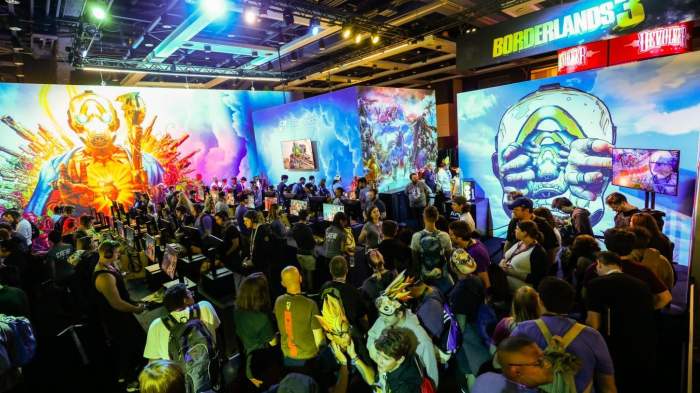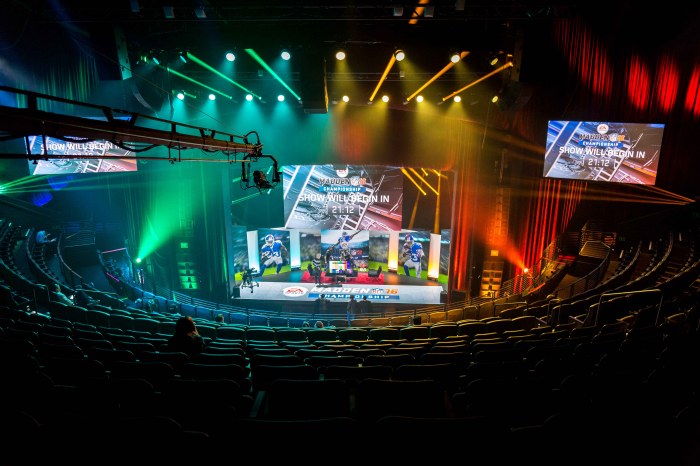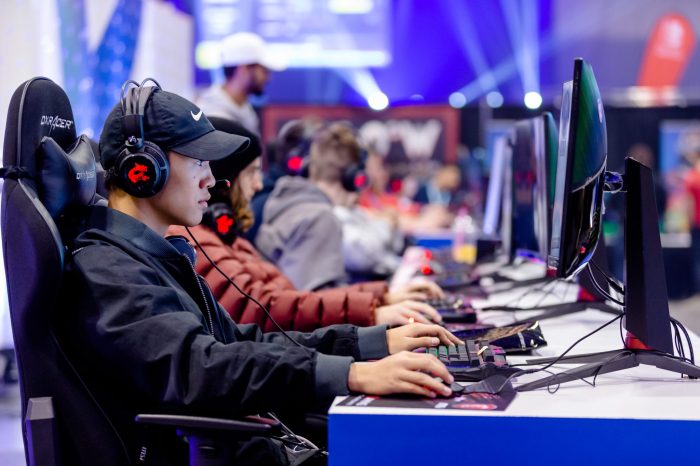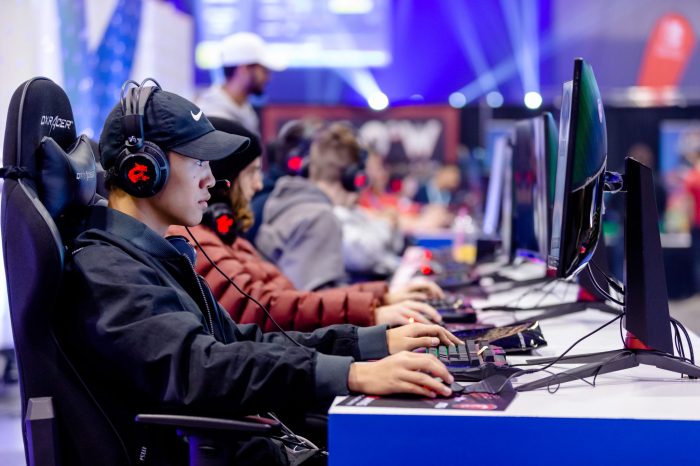Live gaming events are exploding! From massive esports tournaments filling stadiums to intimate Twitch streams in bedrooms, the world of competitive and spectator gaming is bigger than ever. This isn’t just about pixels on a screen; it’s about community, competition, and a whole lot of hype. We’ll break down everything you need to know about these electrifying events, from the tech behind the scenes to the marketing muscle that fuels the frenzy.
We’ll explore the diverse audience, the different types of events, and the innovative ways organizers are making bank (and making memories). Get ready to level up your understanding of this rapidly growing industry.
Defining Live Gaming Events

Live gaming events represent a dynamic and rapidly evolving sector within the broader gaming industry. They encompass a wide range of experiences, from massive esports competitions attracting millions of viewers to smaller, community-focused gatherings centered around specific games or genres. What sets them apart is the element of live, in-person interaction, or a compelling sense of real-time engagement, creating a unique atmosphere that transcends the typical solo or online gaming experience.Live gaming events are characterized by their real-time nature, the presence of an audience (either physical or virtual), and a focus on shared experiences.
Unlike playing a game alone or even online with friends, live events create a sense of community and shared excitement. The competitive aspect, while prominent in some formats, isn’t necessarily a defining feature; the shared experience of watching or participating in gaming activities is paramount. This shared experience can be fueled by the energy of a crowd, the spectacle of professional gameplay, or the opportunity to connect with other passionate gamers.
Types of Live Gaming Events
Live gaming events can be broadly categorized into several distinct types, each with its own unique characteristics and appeal. Understanding these differences helps to appreciate the diverse landscape of the live gaming scene.
Esports Tournaments
Esports tournaments are competitive gaming events featuring professional players competing for prize money and recognition. These events often take place in large arenas or stadiums, with thousands of spectators in attendance and millions more watching online. Examples include The International (Dota 2), The League of Legends World Championship, and the Evolution Championship Series (Fighting Games). The high stakes, professional production, and intense competition draw significant audiences and sponsorships, making them a major component of the live gaming ecosystem.
These tournaments often feature elaborate stage designs, live commentary, and extensive broadcast coverage, transforming the gaming experience into a captivating spectacle.
Gaming Conventions
Gaming conventions, or expos, offer a broader range of experiences than esports tournaments. These events often feature a mix of competitive gaming, game demonstrations, panel discussions, meet-and-greets with developers and personalities, and opportunities for attendees to play games themselves. Examples include PAX (Penny Arcade Expo), E3 (Electronic Entertainment Expo), and Gamescom. The focus here is less on competitive play and more on celebrating the broader gaming culture, fostering community, and showcasing new releases and upcoming games.
Attendees can participate in tournaments, browse vendor booths, attend workshops, and meet fellow gamers, making these events a significant hub for the gaming community.
Live Streams and Online Events
While not strictly “live” in the traditional sense of a physical event, live streams and online events have become integral to the live gaming experience. Platforms like Twitch and YouTube Gaming host countless live streams of both professional and amateur gamers, creating a virtual space for community engagement and shared experiences. These platforms often feature interactive elements, such as chat functionality and donations, that enhance the sense of community and allow viewers to actively participate.
Many esports tournaments and gaming conventions also incorporate live streaming components, extending their reach to a global audience. The rapid growth of this area demonstrates the evolving nature of what constitutes a “live” gaming event. The ability to interact in real-time, regardless of physical location, fundamentally changes how we define and experience gaming events.
Audience and Participation: Live Gaming Events

Live gaming events draw a remarkably diverse crowd, transcending age, gender, and socioeconomic boundaries. The unifying factor is a shared passion for video games, esports, and the thrill of competitive gameplay or the spectacle of high-level skill. Understanding this audience is crucial for event organizers to tailor experiences and maximize engagement.The audience for these events is multifaceted, encompassing casual viewers, hardcore esports fans, families, and even those simply curious about the gaming culture.
This broad appeal is a testament to the growing mainstream acceptance of gaming as a legitimate form of entertainment and sport. The diverse demographics contribute to a vibrant and dynamic atmosphere, creating a unique social environment unlike traditional sporting events.
Demographics of Live Gaming Event Attendees
The audience isn’t a monolith. You’ll find teenagers glued to the action, alongside adults who grew up playing the games now showcased professionally. There’s a significant female presence, often overlooked in past narratives about gaming culture, actively participating as players, spectators, and even organizers. Families attend together, introducing younger generations to the world of esports. This diversity is enriching the spectator experience, fostering a more inclusive and representative atmosphere within the gaming community.
Socioeconomic backgrounds also vary widely, reflecting the accessibility of gaming as a hobby and the broad appeal of esports.
Levels of Participation
Participation in live gaming events spans a wide spectrum. At one end are the spectators, passively enjoying the spectacle of skilled gameplay and the electrifying atmosphere. Their engagement ranges from casual observation to active participation through social media interaction, cheering, and cosplay. Then there are the competitors, the professional gamers whose skill and dedication are the heart of the event.
Their intense focus and strategic play are the main draw for many attendees. Finally, there are the organizers, the unsung heroes behind the scenes, ensuring the event runs smoothly from logistics and technical support to marketing and community management. Each role contributes to the success of the event.
Social and Community Aspects
Live gaming events foster a strong sense of community. The shared passion for gaming creates an immediate bond between attendees, regardless of their background. Spectators often engage in lively discussions, share predictions, and celebrate victories together. Social media platforms further amplify this connection, allowing fans worldwide to participate in the conversation and connect with others who share their enthusiasm.
This shared experience transcends geographical boundaries, creating a global community united by their love of gaming. The energy and excitement are palpable, enhancing the overall viewing experience and contributing significantly to the events’ popularity. The impact on audience engagement is clear; the social element is as much a draw as the competition itself.
Technological Infrastructure

Pulling off a killer live gaming event isn’t just about awesome gameplay; it’s about having the tech to broadcast it flawlessly to a massive audience. Think of it like this: you’ve got the best band in the world, but if your sound system is garbage, nobody’s going to enjoy the show. The same principle applies to live gaming events.
A robust technological infrastructure is the backbone of a successful broadcast, ensuring a smooth and engaging experience for viewers.The successful delivery of a live gaming event relies heavily on a complex interplay between streaming platforms, broadcasting equipment, and powerful game servers. These components work together to capture, process, and distribute the gaming action to a global audience in real-time.
Without a well-planned and redundant infrastructure, even the most exciting game can be ruined by technical glitches, resulting in a negative experience for viewers and potentially significant financial losses for organizers.
Streaming Platforms
Streaming platforms are the digital arteries that carry the live gaming event to the viewers. Popular choices include Twitch, YouTube Live, and Facebook Gaming, each with its own strengths and weaknesses in terms of audience reach, features, and monetization options. The selection of a platform should consider factors like the target audience’s preferred platform, the event’s monetization strategy, and the platform’s technical capabilities, such as scalability and integration with other services.
For instance, Twitch is known for its large gaming community and robust interactive features, while YouTube Live offers broader reach beyond just gamers. Choosing the right platform is crucial for maximizing viewership and engagement.
Broadcasting Equipment
Capturing high-quality video and audio is paramount. This requires a professional-grade setup including high-resolution cameras (multiple angles are ideal for variety), professional microphones (both for in-game audio and commentator commentary), and a powerful video switcher to manage multiple inputs and create a polished broadcast. High-speed internet connectivity with sufficient bandwidth is also critical for uploading the live stream without lag or buffering issues.
Think of the equipment as the instruments of a live band – you need top-quality gear to deliver a top-quality performance. A typical setup might involve several cameras (one focusing on the players, another on the commentator, perhaps one showing the in-game action from a different perspective), high-quality audio mixers to manage different sound sources, and encoding hardware to prepare the video stream for online delivery.
Game Servers
The game servers are the heart of the event, responsible for running the game itself and managing player interactions in real-time. For a large-scale event, multiple servers might be needed to handle the load, and a robust content delivery network (CDN) ensures low latency and consistent performance for viewers worldwide. Game server performance directly impacts viewer experience; lag, disconnections, or other technical issues can significantly detract from the viewing experience.
Therefore, choosing powerful and reliable servers with sufficient capacity to handle the expected number of players and viewers is essential. Furthermore, the servers should be monitored closely throughout the event to proactively address any potential issues. Think of this as the stage itself – a poorly constructed stage would make the performance impossible.
Hypothetical Technological Setup for a Large-Scale Event
For a large-scale live gaming event, like a major esports tournament, a highly redundant and robust infrastructure is necessary. This would include multiple streaming encoders, each feeding different streaming platforms. If one encoder fails, others immediately take over, ensuring uninterrupted broadcasting. Multiple, geographically dispersed game servers would handle the player load, preventing overload and ensuring low latency for players around the world.
A robust CDN would distribute the stream to viewers globally, minimizing buffering and lag. A dedicated team of IT professionals would monitor the entire system 24/7, proactively identifying and resolving any potential issues before they impact viewers. This setup would incorporate fail-safe mechanisms at every level, from backup power generators to redundant internet connections, minimizing the risk of disruption and ensuring a seamless experience for viewers.
Think of it as a meticulously planned military operation – every contingency is covered.
The Future of Live Gaming Events
Live gaming events are rapidly evolving, driven by technological advancements and a growing demand for immersive and interactive experiences. The future of these events promises a blend of physical and digital realms, pushing the boundaries of what’s possible in terms of audience engagement and spectacle. We’ll explore some key trends shaping this exciting landscape.
Emerging Trends and Technologies, Live gaming events
Several technological advancements are poised to revolutionize live gaming events. The integration of 5G and improved network infrastructure will enable seamless streaming and real-time interaction, regardless of location. This allows for greater scalability, potentially connecting millions of viewers simultaneously with minimal lag. Furthermore, the increasing sophistication of game engines and development tools will lead to more visually stunning and technically complex events, pushing the boundaries of what’s possible within the virtual world.
For example, we’re already seeing the rise of hyper-realistic graphics and physics simulations that blur the lines between the virtual and real worlds. This is particularly noticeable in esports events, where the visual fidelity of the games themselves is a key component of the spectacle. Finally, the development of advanced analytics tools allows event organizers to better understand audience behavior, preferences, and engagement, enabling them to tailor future events to meet evolving needs and expectations.
The Impact of Virtual and Augmented Reality
Virtual Reality (VR) and Augmented Reality (AR) are set to transform the live gaming experience. VR offers the potential for fully immersive spectator experiences, allowing viewers to feel as if they are present at the event, even from thousands of miles away. Imagine a VR experience that places viewers directly into the stadium, allowing them to feel the energy of the crowd and experience the game from various perspectives.
AR, on the other hand, can overlay digital elements onto the real world, enhancing the in-person experience. For instance, AR apps could provide real-time game statistics, player profiles, and interactive elements overlaid onto the physical event space. This could enhance understanding and excitement for both casual and dedicated fans. Consider an AR app that allows spectators to see a player’s health and stats as they move across the screen during a live match, or which provides commentary and highlights through interactive elements projected onto the venue.
Innovative Approaches to Audience Engagement
The future of live gaming events hinges on creating innovative ways to engage audiences. One approach involves personalized experiences, utilizing data to tailor content and interactions to individual preferences. This could range from customized game commentary to interactive challenges and rewards based on viewer participation. Another key development is the incorporation of social media and interactive streaming platforms to foster a sense of community and allow viewers to actively participate in the event.
Think of live polls, Q&A sessions with players, and challenges that allow viewers to directly impact the game or event flow. Finally, the use of gamification techniques can transform passive spectators into active participants. This might involve rewarding viewers for correct predictions, completing challenges, or simply engaging with the event through social media. For example, viewers could earn points for correct predictions about game outcomes or player performances, which can be redeemed for prizes or exclusive content.
Visual Elements and Branding

Creating a truly memorable live gaming event hinges on more than just the gameplay; it’s about crafting an immersive and engaging experience for the audience. Visual elements and a strong brand identity are crucial for achieving this, shaping the overall perception and leaving a lasting impression on attendees and viewers alike. Think of it like this: a killer game is the core, but the visuals and branding are the polish that makes it shine.Visual elements, from the smallest logo to the grandest stage design, contribute significantly to the atmosphere and memorability of a live gaming event.
A well-executed visual strategy can amplify the excitement, enhance the emotional connection with the game, and ultimately, increase audience engagement. Conversely, a lackluster visual presentation can easily diminish the impact of even the most thrilling competition.
Stage Design for a Hypothetical Esports Tournament
Imagine a tournament for “Project Chimera,” a futuristic, team-based shooter. The stage itself is a massive, multi-level structure resembling a futuristic cityscape, complete with towering holographic skyscrapers that dynamically shift and change color based on in-game events. The main competition area is a raised platform, centrally located and surrounded by a wraparound LED screen displaying real-time game statistics, player profiles, and spectacular visual effects synchronized with the gameplay.
Beneath the platform, a smaller, secondary stage hosts pre- and post-match interviews and analysis, bathed in a cooler, more subdued blue light.Lighting plays a crucial role in setting the mood. During intense moments of gameplay, vibrant, pulsating lights in shades of electric blue, neon pink, and fiery orange synchronize with the action on screen, creating an electrifying atmosphere.
Subtle, atmospheric lighting is used during calmer moments, such as pre-game introductions or post-match interviews, helping to create a sense of anticipation or reflection. The sound design complements the visuals, featuring a custom-composed soundtrack that dynamically adjusts to the intensity of the gameplay, punctuated by powerful sound effects that enhance the impact of in-game events. Finally, subtle fog effects and strategically placed laser beams add to the overall futuristic aesthetic, creating a truly immersive and unforgettable experience.
Branding and Consistent Identity
Branding is essential in establishing a recognizable and consistent identity for a live gaming event. A strong brand allows for easy audience identification and creates a sense of community and belonging. This involves more than just a logo; it’s about creating a cohesive visual language that extends across all aspects of the event, from tickets and merchandise to social media campaigns and on-site signage.For example, “Project Chimera’s” branding might incorporate a stylized logo featuring a chimera-like creature, perhaps incorporating futuristic elements and vibrant colors that reflect the game’s aesthetic.
This logo would then be consistently used across all marketing materials, merchandise, and even the stage design itself. A consistent color palette and font style would further reinforce the brand identity, ensuring that every element feels connected and contributes to a unified visual experience. This cohesive approach helps to create a memorable and impactful event that resonates with the audience long after the tournament concludes.
Frequently Asked Questions
What’s the difference between esports and a gaming convention?
Esports focuses on competitive gaming tournaments with professional players, while gaming conventions are broader events with a mix of tournaments, exhibitions, panels, and community gatherings.
How much does it cost to put on a live gaming event?
Costs vary wildly depending on scale, but you’re looking at significant expenses for venue rental, tech infrastructure, marketing, talent fees, and more. Smaller events might cost a few thousand, while large-scale esports tournaments can cost millions.
How can I get involved in live gaming events?
You can attend as a spectator, compete in tournaments (if you’re skilled!), volunteer, work for an organizer, or even sponsor an event. Plenty of avenues exist depending on your interests and skills.
What are some emerging trends in live gaming events?
VR/AR integration, personalized viewer experiences, interactive streaming, and greater focus on community building are all shaping the future of live gaming events.
